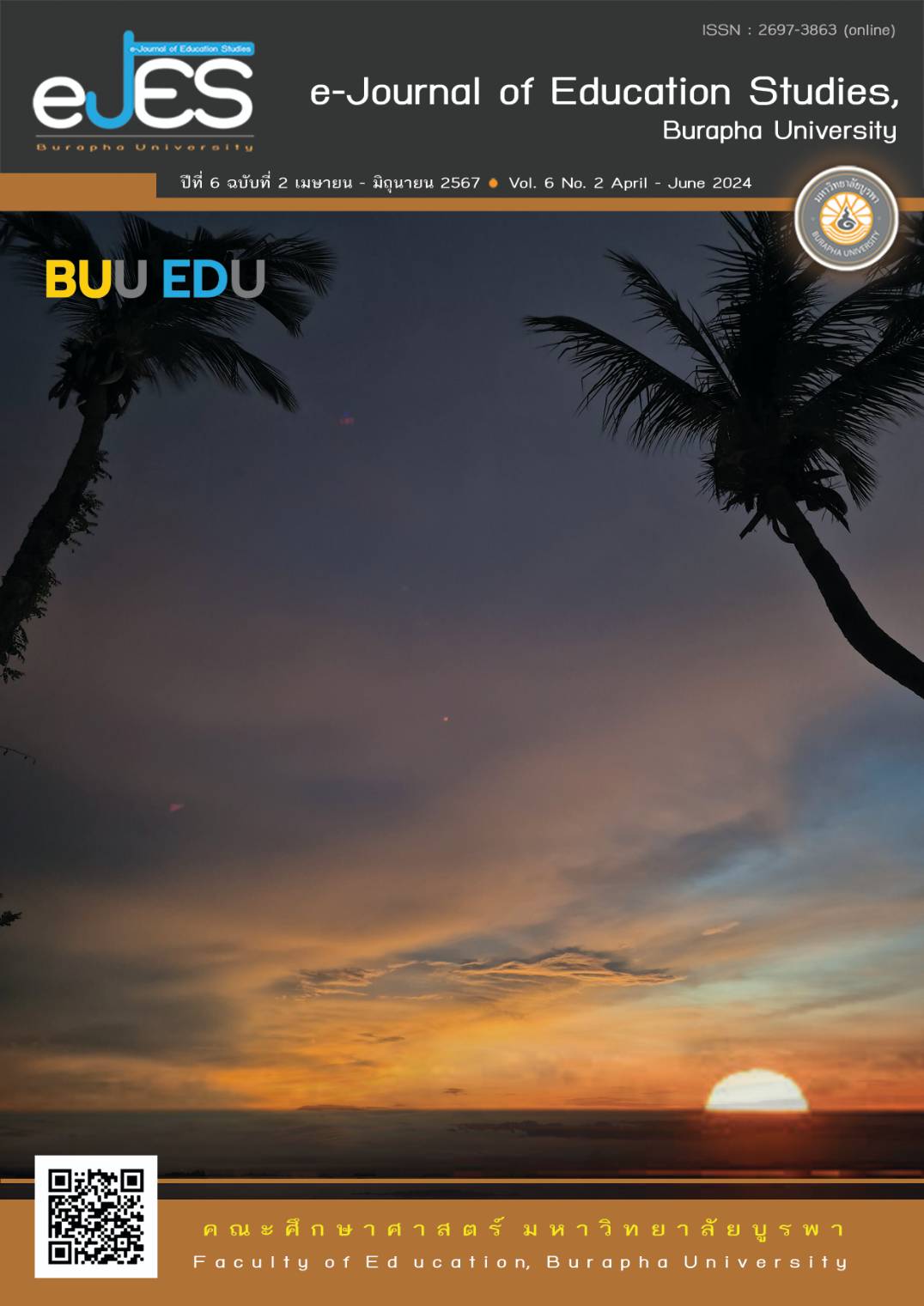ผลของโปรแกรมนิทานดนตรีตามทฤษฎีเกสตอลท์ต่อความสนใจจดจ่อ ของนักเรียนหญิงชั้นประถมศึกษาตอนต้น
Main Article Content
บทคัดย่อ
การวิจัยนี้มีวัตถุประสงค์เพื่อ 1) เปรียบเทียบความสนใจจดจ่อของนักเรียนหญิงชั้นประถมศึกษาในกลุ่มทดลองที่ได้รับโปรแกรมนิทานดนตรีตามทฤษฎีเกสตอลท์ ระหว่างก่อนทดลอง หลังทดลอง และระยะติดตามผล 2) เปรียบเทียบความสนใจจดจ่อของนักเรียนหญิงชั้นประถมศึกษาระหว่างกลุ่มทดลองกับกลุ่มควบคุมในระยะหลังทดลองและติดตามผล กลุ่มตัวอย่างเป็นนักเรียนหญิงชั้นประถมศึกษาตอนต้น โรงเรียนเอกชนแห่งหนึ่ง อายุ 6-9 ปี จำนวน 36 คน ที่มีคะแนนจากแบบทดสอบความสนใจจดจ่อ เรียงคะแนนจากมากสุดไปน้อยสุด จับคู่คะแนนจัดเข้ากลุ่มควบคุมและกลุ่มทดลอง กลุ่มละ 18 คน กลุ่มทดลองได้รับโปรแกรมนิทานดนตรีตามทฤษฎีเกสตอลท์ จำนวน 8 ครั้ง ครั้งละ 50 นาที สัปดาห์ละ 2 ครั้ง รวมทั้งสิ้น 4 สัปดาห์ ส่วนกลุ่มควบคุมได้รับการเรียนการสอนปกติ ทดสอบผลการทดลอง 3 ระยะ ได้แก่ ก่อนการทดลอง หลังการทดลอง และระยะติดตามผล 3 สัปดาห์ วิเคราะห์ความแปรปรวนแบบวัดซ้ำ ประเภทหนึ่งตัวแปรระหว่างกลุ่ม และหนึ่งตัวแปรภายในกลุ่ม และเปรียบเทียบเป็นรายคู่ด้วยวิธีของบอนเฟอร์โรนี
ผลการวิจัย พบว่า 1) กลุ่มทดลองมีคะแนนความถูกต้องในการตอบสนองต่อสิ่งเร้าระยะหลังทดลอง และติดตามผลสูงกว่าก่อนทดลอง และสูงกว่ากลุ่มควบคุม อย่างมีนัยสำคัญทางสถิติที่ระดับ.05 2) กลุ่มทดลองมีคะแนนเวลาปฏิกิริยา ระยะติดตามผลต่ำกว่าหลังทดลอง และต่ำกว่ากลุ่มควบคุม ทั้งระยะหลังทดลอง และติดตามผล อย่างมีนัยสำคัญทางสถิติที่ระดับ .05 สรุปได้ว่า โปรแกรมนิทานดนตรีตามทฤษฎีเกสตอลท์สามารถเพิ่มความสนใจจดจ่อของนักเรียนหญิงชั้นประถมศึกษาได้
Article Details
เอกสารอ้างอิง
Carlson, S. M., & Moses, L. J. (2001). Individual differences in inhibitory control and children's theory of mind. Child Development, 72(4), 1032-1053. doi:10.1111/1467-8624.00333
Chang, C., Crottaz-Herbette, S., & Menon, V. (2007). Temporal dynamics of basal ganglia response and connectivity during verbal working memory. Neuroimage, 34(3), 1253-1269. doi:10.1016/j.neuroimage.2006.08.056
Chun, M. M., Golomb, J. D., & Turk-Browne, N. B. (2011). A taxonomy of external and internal attention. Annual Review of Psychology, 62(1), 73-101. doi:10.1146/annurev.psych.093008.100427
Deutsch, J. A., & Deutsch, D. (1963). Attention: some theoretical considerations. Psychological Review, 70(1), 80-90.
Fernandez-Duque, D., & Posner, M. I. (2001). Brain imaging of attentional networks in normal and pathological states. Journal of Clinical and Experimental Neuropsychology, 23(1), 74-93. doi:10.1076/jcen.23.1.74.1217
Frankenberger, W. (1979). Relaxation Training with Aggressive Mentally Retarded Adults [microform] : A Failure to Observe Carry-Over Effects / William Frankenberger. Washington, D.C.: Distributed by ERIC Clearinghouse.
Gentile, B., Twenge, J., Freeman, E., & Campbell, W. K. (2012). The effect of social networking websites on positive self-views: An experimental investigation. Computers in Human Behavior, 28, 1929–1933. doi:10.1016/j.chb.2012.05.012
Himmelheber, A., Sarter, M., & Bruno, J. (2000). Himmelheber AM, Sarter M, Bruno JP. Increases in cortical acetylcholine release during sustained attention performance in rats. Brain Res Cogn Brain Res 9: 313-325. Brain research. Cognitive brain research, 9, 313-325. doi:10.1016/S0926-6410(00)00012-4
Hobson, J. A. (2009). REM sleep and dreaming: towards a theory of protoconsciousness. Nature Reviews Neuroscience, 10(11), 803-813. doi:10.1038/nrn2716
Holmes, E., & Mathews, A. (2005). Mental Imagery and Emotion: A Special Relationship? Emotion, 5(4), 489-497. doi:10.1037/1528-3542.5.4.489
Howell, K. (2013). An Introduction to the Philosophy of Methodology. New Delhi : SAGE.
Johnson, J. G., Cohen, P., Kasen, S., & Brook, J. S. (2007). Extensive television viewing and the development of attention and learning difficulties during adolescence. Archives Pediatrics & Adolescent Medicine, 161(5), 480-486. doi:10.1001/archpedi.161.5.480
Koffa, K. (1935): Principles of Gestalt Psychology. London: Routledge & Kegan Paul.
Köhler, W. (1920): Physical Gestalten (Die Physischen Gestalten in Ruhe und im stationaren Zustand). Erlangen: Eine naturphilosophische Untersuchung: ix-259. [Ellis, W. D. (Ed.) (1938): A sourcebook of Gestalt psychology. London: Routledge & Kegan Paul: 17-54].
Morris, R. W., Sparks, A., Mitchell, P. B., Weickert, C. S., & Green, M. J. (2012). Lack of cortico-limbic coupling in bipolar disorder and schizophrenia during emotion regulation. Translational Psychiatry, 2(3), e90. doi:10.1038/tp.2012.16
Mueller, S. T., & Piper, B. J. (2014). The Psychology Experiment Building Language (PEBL) and PEBL Test Battery. Journal of Neuroscience Methods, 222, 250-259. doi:10.1016/j.jneumeth.2013.10.024
Neokleous, K. C., & Schizas, C. N. (2011). Computational Modeling of Visual Selective Attention. Paper presented at the European Future Technologies Conference and Exhibition.
Petersen, S. E., & Posner, M. I. (2012). The attention system of the human brain: 20 years after. Annual Review of Neuroscience, 35, 73-89. doi:10.1146/annurev-neuro-062111-150525
Poe, G. R., Walsh, C. M., & Bjorness, T. E. (2010). Cognitive neuroscience of sleep. Progress in Brain Research, 185, 1-19. doi:10.1016/b978-0-444-53702-7.00001-4
Posner, M. I., & DiGirolamo, G. J. (1998). Executive attention: Conflict, target detection, and cognitive control. In R. Parasuraman (Ed.), The attentive brain (pp. 401–423). Cambridge: The MIT Press.
Posner, M. I., & Rothbart, M. K. (2007). Research on attention networks as a model for the integration of psychological science. Annual Review of Psychology, 58, 1-23. doi:10.1146/annurev.psych.58.110405.085516
Rothbart, M. K., Ziaie, H., & O'Boyle, C. G. (1992). Self-regulation and emotion in infancy. New Directions for Child Development, (55), 7-23. doi:10.1002/cd.23219925503
Sarter, M., & Lustig, C. (2009). Attentional Functions in Learning and Memory. Encyclopedia of the Neuroscience
Sternberg, R. J. (2012). A Model for Ethical Reasoning. Review of General Psychology, 16(4), 319-326. doi:10.1037/a0027854
Sternberg, R. J., & Stemberg, K. (2012). Cognitive Psychology (6th ed.). Belmont, California: Wadsworth.
Swing, E. L., Gentile, D. A., Anderson, C. A., & Walsh, D. A. (2010). Television and video game exposure and the development of attention problems. Pediatrics, 126(2), 214-221. doi:10.1542/peds.2009-1508
Tanni, Z., & Mahmoud Raba, A. (2015). Storytelling as an aid in promoting oral proficiency of grade eleven students from teachers’ perspectives in Tulkarm district. US-China Foreign Language, 13(10), 710-722. doi:10.17265/1539-8080/2015.10.004
Todorović, D. (2011). What is the Origin of the Gestalt Principles. Humanamente, 17, 1–20.
Unsworth, N., Fukuda, K., Awh, E., & Vogel, E. K. (2014). Working memory and fluid intelligence: capacity, attention control, and secondary memory retrieval. Cognitive Psychology, 71, 1-26. doi:10.1016/j.cogpsych.2014.01.003
Warr, P. (1990). The Measurement of Well-Being and Other Aspects of Mental Health. Journal of Occupational and Organization Psychology, 63(3), 193-210. doi:10.1111/j.2044-8325.1990.tb00521.x
Wertherimer, M. (1924). Gestalt Theory (Uber Gestalttheorie): 39-59, [Ellis, W. D. (Ed.) (1938): A sourcebook of Gestalt psychology. London: Routledge & Kegan Paul: 1-11].
Winer B. J. Brown D. R. & Michels K. M. (1991). Statistical principles in experimental design (3rd ed.). New York : McGraw-Hill.
Yontef, G., & Jacobs, L. (2008). Gestalt therapy. Current Psychotherapies, 342-382.



